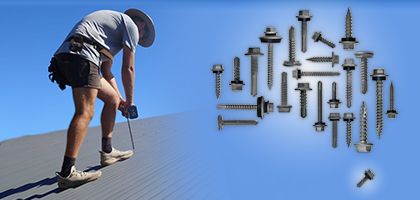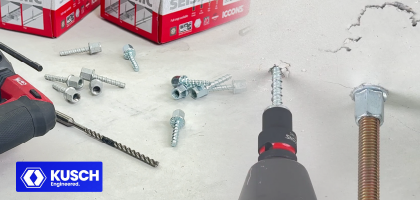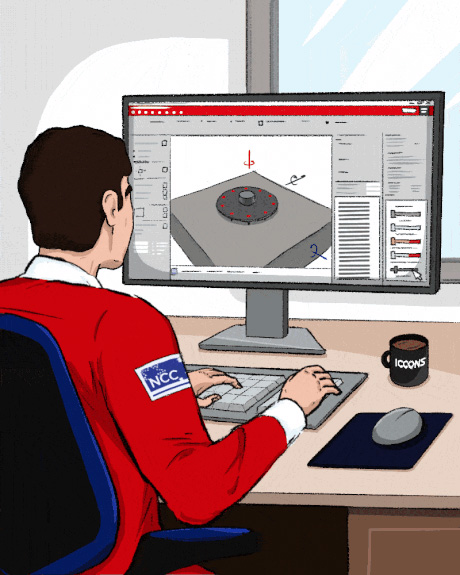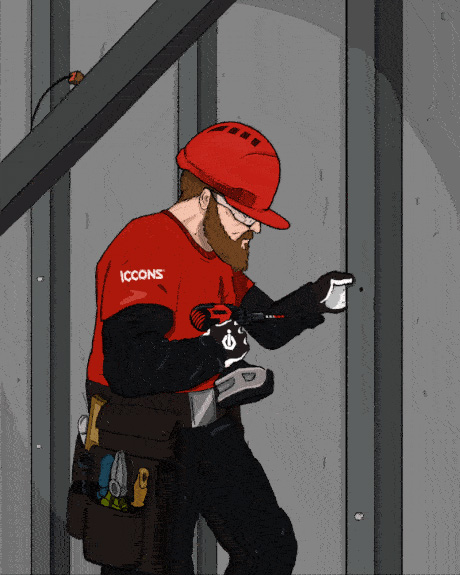If you own or operate a construction supply outlet, you may be eligible to supply ICCONS range of construction fastening supplies at wholesale prices!
- Log In
- Sitebox
- Contact
- Find a dealer
-
Anchoring
Anchoring
- Screw Bolts
- Thru-Bolt Stud Anchors
- FM753 - Heavy Duty Through Anchors
- ATS-EVO Heavy Duty Anchors
- STA-EVO Heavy Duty Anchors
- Hangerz
- Drop-In Anchors
- Suspension and Tie Wire Anchors
- Sleeve Anchors
- Panel Brace Anchors
- Friulsider Nylon Anchors
- Metal - Light Duty
- Nylon - Light Duty
- Plasterboard and Hollow Cavity Wall Anchors
- Plastic Wall Plugs and Spaghetti
- Strike Anchors
-
Pipe Clamps
Anchoring
-
Cast-In Anchors
Anchoring
- Shims and Other
-
Hollow Section Fittings
Anchoring
-
Adhesives
Adhesives
-
Nailing
Nailing
- Rivets
-
Screws
Screws
-
Self Drillers
Screws
- Self Drilling Bugle Head
- STET Aesthetic Architectural Tamper Resistant Screw
- Self Drilling Button Head
- Self Drilling Countersunk Head
- Self Drilling Countersunk Wing
- Self Drilling Flathead
- Self Drilling Hex Head
- Self Drilling Mushroom Head
- Self Drilling Pan Head
- Self Drilling Trade Packs
- Self Drilling Trade Tubs
- Self Drilling Wafer Head
- Self Drillers
- Type 17
- Collated
-
Decking
Screws
- Needle Point
- Chipboard
- Cyclonix
-
Painted Screws
Screws
- Painted - Needle Point Hex Head
- Painted - Self Drilling Button Head
- Painted - Self Drilling Flathead
- Painted - Self Drilling Hex Head
- Painted - Self Drilling Multiseal - 14 Gauge
- Painted - Self Drilling Trade Packs
- Painted - Self Drilling Trade Tubs
- Painted - Self Drilling Wafer Head
- Painted - Type 17 Cyclonix - 14 Gauge
- Painted - Type 17 Hex Head
- Painted Screws
- Muro - Collated Screw Solutions
-
Self Drillers
-
Drilling
Drilling
- Drilling - SDS Plus
- Drilling - SDS Max
- Dustless Drilling
-
Drilling Power Tool Accessories
Drilling
- Countersinking / Pre-Drilling Accessories
- Impact Fastdrive - Bit Holders
- Impact Fastdrive - Bit Kits
- Impact Fastdrive - Insert Bits
- Impact Fastdrive - Nut Setters
- Impact Fastdrive - Power (Double Ended) Bits
- Impact Fastdrive - Power Bits
- Standard Fastdrive - Bit Holders
- Standard Fastdrive - Insert Bits
- Standard Fastdrive - Nut Setters
- Standard Fastdrive - Power Bits
- Impact Sockets
- Drill Attachments
- Tile Bits
- Ratioquick Core Bits and Accessories
- Drilling Power Tool Accessories
- Metal / Wood / Concrete Kits
-
Diamond
Diamond
-
Tools
Tools
-
Other
Other
- Support & Downloads
- Partners
- Careers
- About
Dealer Login
Changes to post-installed and cast-in fastenings designed for use in concrete
27 June 2019
It's the law to comply
Australia has now introduced two very major changes on how post-installed fasteners (fixings) are designed and specified into concrete in buildings from 2019. Specifiers, suppliers, users, design engineers and installers need to be urgently aware of these new requirements and how they will directly affect them.Why are these changes happening?
Unfortunately, there have been numerous failures of fasteners in Australia and overseas, because of improper design, selection, and installation. New regulations have been implemented to improve the industry and prevent potentially catastrophic failures occurring in the future.
These changes will have a dramatic impact on the selection of post-installed fasteners, as these new regulations are mandatory, and a legal requirement for any future building work where post-installed fasteners are used!
Change #1
The first change is the publication of the new design provisions for cast-in and post-installed fastenings into concrete for use in Australia. Published by Standards Australia in late 2018 titled AS 5216:2018 “Design of post-installed and cast-in fastenings in concrete”.
The organisation the Australian Engineered Fasteners and Anchor Council (AEFAC) initiated this Standard. AEFAC is an industry initiative seeking to enhance the specification, selection, design and installation of structural anchors and fasteners in the Australian construction industry because of concerns of poor selection and use of the fasteners. The new Standard was developed by an expert committee representing relevant organisations in the fastening industry. AEFAC has an excellent website with considerable technical information which can be downloaded for free on the AEFAC website.
This New Standard requires cast-in and all post-installed fasteners to be considered either as safety critical or non-critical fasteners.
- Safety-critical applications are defined as fastenings where failure may result in collapse or partial collapse of the structure, endanger human life and/or cause considerable economic loss.
- Non-critical applications would be fasteners into concrete where failure is not likely to endanger human life or result in a substantial economic cost.
The determination of a Safety-Critical Application should be made by the design engineer or the person responsible for the installation if they have the necessary design skills. ICCONS Nationwide Engineering support team is designed to handle these types of enquiries. All safety-critical fasteners must be designed for the appropriate design loads as set out in the National Construction Code (NCC) 2019.
The other important issue with the new Standard is that it assumes that the concrete into which the post-installed fixing, is to be placed, is cracked.
The definition of cracked concrete is concrete that is likely to experience cracking during its lifetime; justification would need to be provided if uncracked properties are adopted by a suitably qualified engineer by a stress analysis or similar. For further information on what constitutes cracked concrete, refer to the website for further discussion on cracked concrete click here.
Post-installed fasteners in cracked concrete are tested in accordance with European practices (ETA). Not all available fasteners will be suitable for cracked concrete or have test data. Particularly thin wall and cheaper fasteners such as the “loxin and dynabolt” style of fasteners as well as some current chemical anchors will not be suitable as they have not been tested for cracked concrete. In addition, the load capacities of post-installed fasteners into cracked concrete are significantly less than those for previously used for uncracked concrete.
Many post-installed fasteners that have typically been used in the past will no longer be suitable for safety-critical applications in cracked concrete.
Retailers, you also have an obligation to ask the question of your customers, "are these fasteners being used for a safety-critical application?" as well as educate your customers on their statutory requirements and the need for correct design.
Change #2
The second significant change which has occurred is the publication of the National Construction Code (NCC) 2019 which was adopted by all States and Territories on the 1 May 2019.
There are three volumes which cover building construction in Australia. Volume 1 contains the requirements for multi-residential, commercial, industrial and public buildings and structures and volume 2 contains the requirements for residential and non-habitable buildings and structures. Volume 3 covers plumbing and drainage.
- Within volumes 1 and 2 of the NCC, there is a statutory requirement that all Post-installed and cast-in fastenings shall be determined according to: AS 5216:2018.
- Because the clauses are in the structural sections of the NCC volume does not mean that they do not apply for all sections of the building.
- Assuming that the design of the building is based on the deemed to comply methods, which most buildings are, then all post-installed fasteners must comply with AS 5216:2018.
These requirements are mandatory and a legal obligation.
This means post-installed fasteners must be designed by a suitably qualified and experienced engineer for the correct design loads (dead, live, wind and seismic as applicable) as set out in the Standards and statutory requirements of the NCC.
Therefore, the designer of post-installed fasteners will need to establish the following:
- Determine whether the post-installed fastener application is safety-critical or not.
- If it is safety critical fastening to choose a suitable fastener appropriate to the location which may be for example an expansion fastener, concrete screw fasteners or chemical fasteners.
For a safety-critical application, the fastener must be:
- Designed by a qualified engineer for the correct loads
- You cannot assume because a fixing has an ETA approval it is adequate, as it needs to be designed to the specific application
- Application specific cracked concrete assessment completed
- An Approved fastener provided by your fastener supplier
- No longer can post-installed fasteners be guessed, and they need to be designed for the specified loads. This will require specific engineering input or possibly design advice from your supplier or others as appropriate if they can provide that technical advice
The designer of post-installed fasteners will need to establish the following (continued):
- Determine the durability of the post-installed fasteners for the exposure location. Zinc plated post-installed fasteners should not be used in external applications and galvanised finishes should be a minimum requirement. Also, be aware of dissimilar metals such as galvanised and stainless steel. It is always preferable to have the same grade of material for the base material and the fastener if possible to avoid this issue. For example, grade 316 fasteners could be used with stainless steel grade 316 material to be fixed.
- Most types of post-installed fasteners are sensitive to installation practice, and you should consider AEFAC Installer Training for your installers. The importance of following the manufacturer installation procedures is vital. The installation requirements may vary across products and from manufacturer to manufacturer who have technical data on installation. Reputable suppliers can provide on-site inspections and for heavily loaded fasteners and offer load testing if required. The training of installers is frequently overlooked which can be the cause of gross errors during installation that in turn could have catastrophic consequences.
In the UK, SCOSS (Standard Committee on Structural Safety) has also been concerned for some time at the use of structural fasteners where these so-called ‘minor’ items have not received the design attention they deserve, given their safety-critical nature. Fixing problems make up 10% of all reports to SCOSS and of these, many have related to post-drilled fixings. Click here for more.
As part of your risk management, you need to change your choice and the design of post-installed fasteners immediately. Otherwise, you could expose yourself to legal action should failures occur for any building work commenced after the 1 May 2019, because of the use of incorrect post-installed fasteners.
Need further support?
Get in touch with our technical experts today
Don't forget to follow us on Facebook, Instagram and LinkedIn to stay in touch with other relevant updates!
Latest articles
-
 20 May 2025
20 May 2025ICCONS Stands Proud as a Home-Grown Brand
With many iconic Australian fixing and fastening brands now in the hands of offshore giants, ICCONS stands firm. Australian owned and operated.
Read More -
 30 April 2025
30 April 2025What's New 🔥 New Recyclable Trade Pack & Trade Tub Packaging!
ICCONS® Takes Another Step Towards Sustainability with New Recyclable Packaging!
Read More -
 5 March 2025
5 March 2025Expert Tips on Seismic Anchoring: Insights from ICCONS and KUSCH
The importance of proper selection and installation of concrete screw anchors, including ICCONS’ Thunderbolt® PRO, in seismic-rated applications.
Read More


